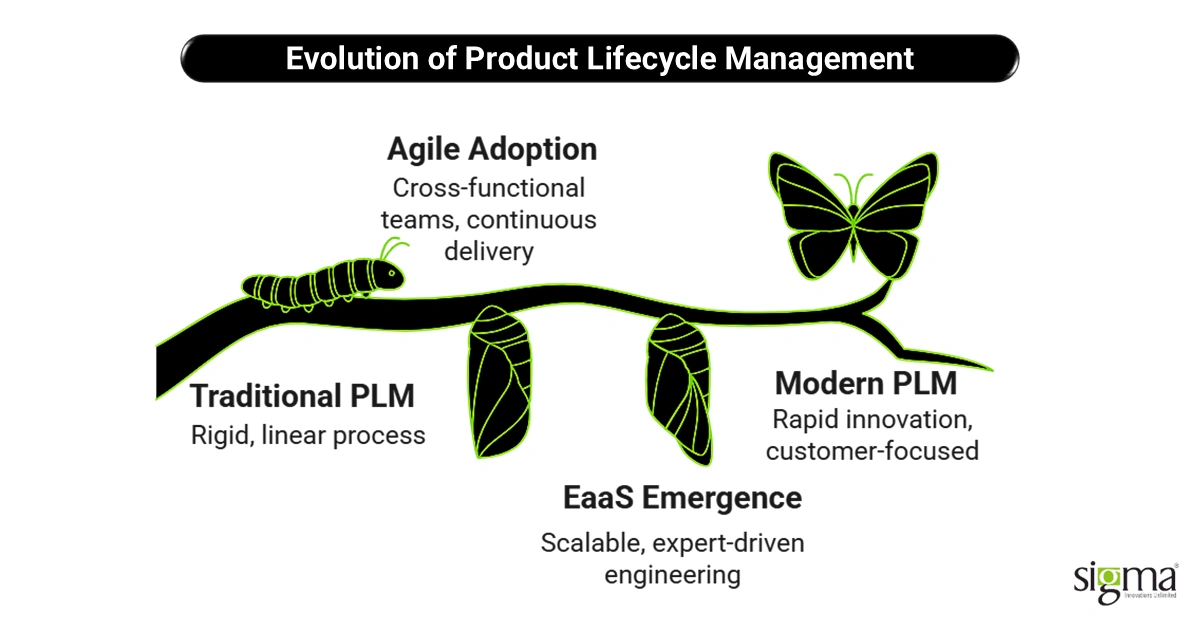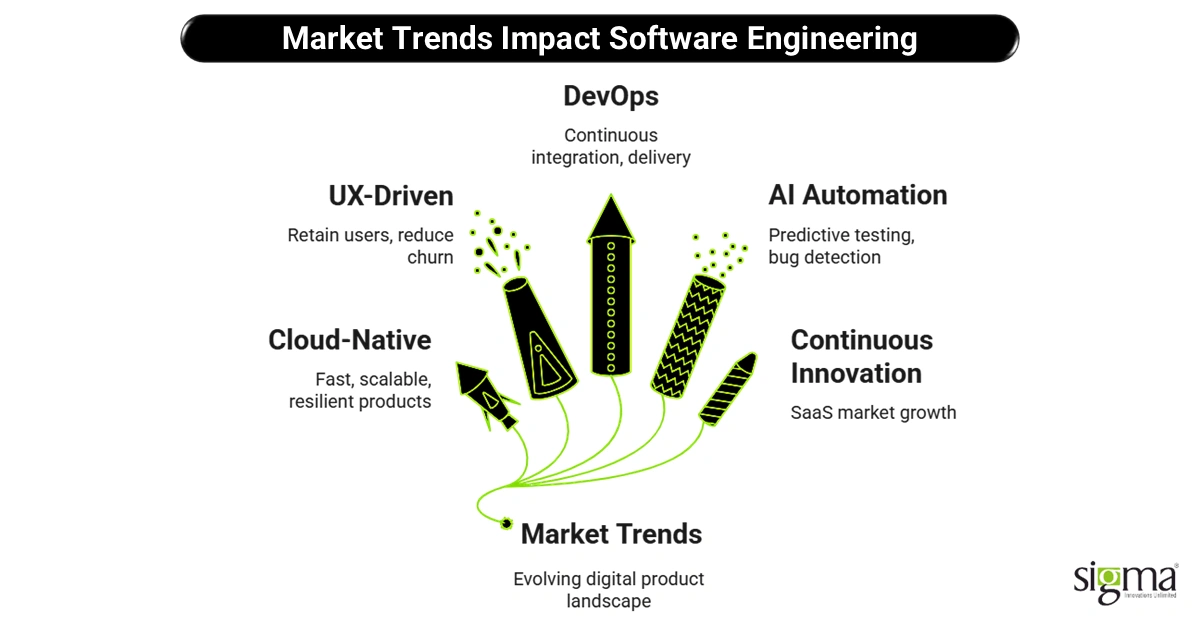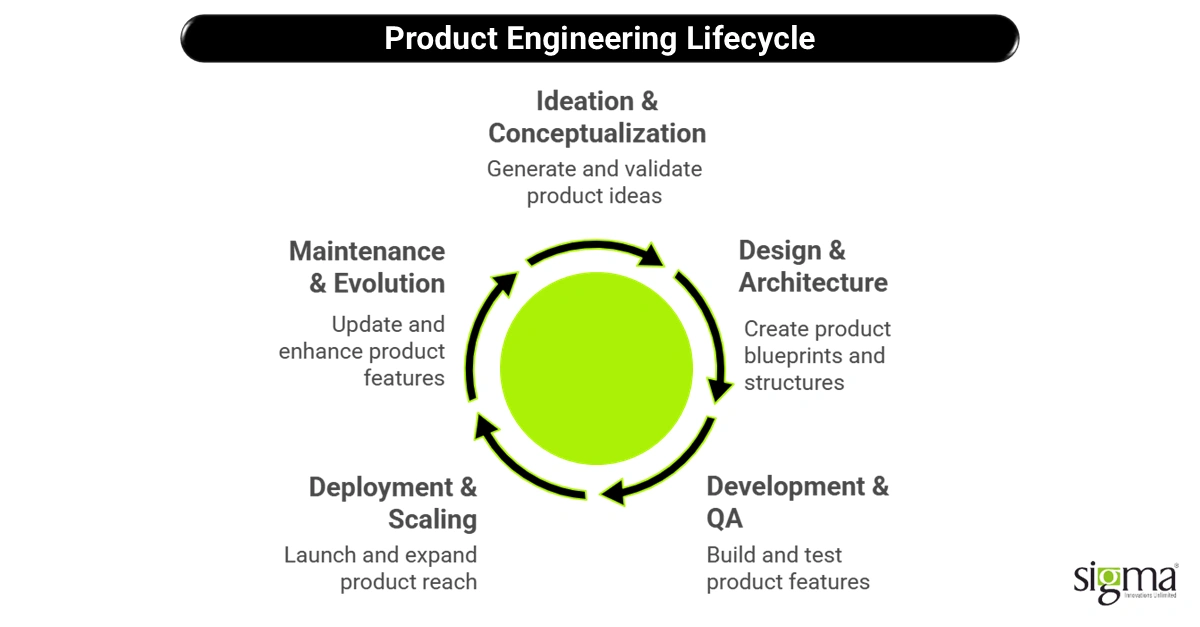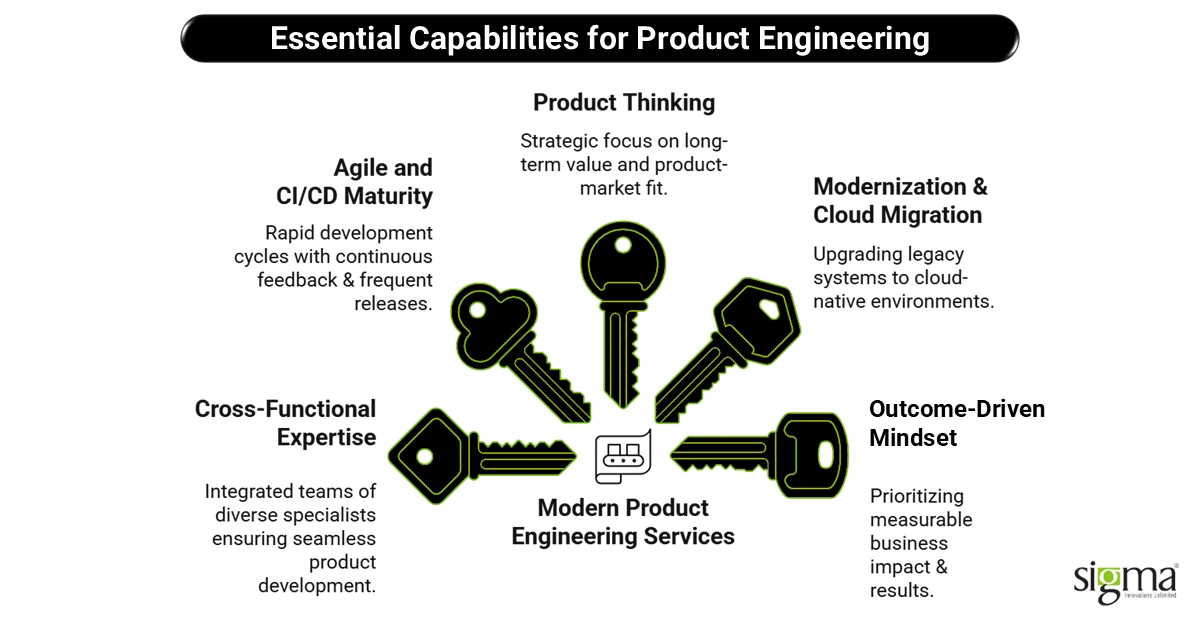How Product Engineering Services Power the Entire Product Lifecycle

Gone are the days when building software was just about writing code and shipping it. Today’s digital-first economy demands more — faster releases, cloud-native scalability, user-obsessed design, and seamless integration. That’s where product engineering services step in.
Unlike traditional software development that mainly focuses on coding and delivery, software product engineering services cover the entire product lifecycle — from the spark of an idea to real-world deployment, continuous updates, and even modernization. It’s a strategic, full-stack approach that blends agile product development services, customer experience, DevOps, and future-readiness into one streamlined engine.
With the rise of SaaS-first models, personalized experiences, and on-demand everything, the pressure on businesses is real. Products must launch faster, work smarter, and evolve constantly. And that’s exactly what digital product engineering services are designed for — they don’t just build digital products, they power their evolution.
At Sigma Infosolutions, we believe that product engineering services are the backbone of digital disruption. Our approach combines end-to-end product engineering, rapid prototyping, cloud adoption, and UX-driven product development to help businesses not just survive change — but lead it.
In this blog, we’ll break down how product engineering services companies in the USA are enabling smarter, faster, and future-ready products. From ideation to innovation to reinvention — we’ll show you how a solid product engineering strategy supports the entire digital product journey.
The Evolution of Product Lifecycle Management (PLM) and the Rise of Engineering-as-a-Service
Software development has come a long way from its early days. Back then, product lifecycle management (PLM) was a rigid, linear process—one that followed the Waterfall model closely. Teams would spend months building specs, more months coding, and even longer testing before anything reached the market. Feedback loops were slow, innovation was limited, and user needs often got lost in translation.
Fast forward to today, and the shift has been radical.

What Changed?
Here’s how the PLM journey has evolved over time:
- Then: Monolithic systems, siloed teams, Waterfall methodology
Now: Cloud-native platforms, cross-functional squads, and Agile product development services - Then: Product releases every 6–12 months
Now: Continuous delivery, CI/CD pipelines, real-time feature rollouts - Then: Heavy in-house engineering investment
Now: Scalable, expert-driven Engineering-as-a-Service (EaaS)
This evolution gave rise to what we now call product engineering excellence—a model where businesses focus on their core vision and let specialized product engineering services companies in the USA handle the heavy lifting of development, innovation, and iteration.
With rising pressure to innovate quickly, control costs, and meet customer expectations, more companies are turning to end-to-end product engineering partners. These partners help transform ideas into scalable digital products with rapid MVP rollouts, iterative development, and built-in future-readiness.
Why Companies Are Embracing Engineering-as-a-Service:
- Access to top-tier talent and niche skills
- Faster time-to-market with Agile product development services
- Better scalability and reduced CapEx
- Strategic product roadmap support from ideation to modernization
- Alignment with DevOps for product lifecycle management
The growth in outsourcing has led to a sharp rise in demand for product engineering services companies in the USA, where businesses value both innovation and accountability.
Market Trends Shaping Product Engineering Today
The digital product landscape is evolving faster than ever, and product engineering services are adapting in real-time. Companies aren’t just building digital products — they’re continuously refining, scaling, and innovating them. In this section, we’ll break down the top five trends shaping how software product engineering services are delivered today.

Trend 1: Cloud-Native Product Development
Today, digital products must be fast, scalable, and resilient. That’s why cloud-native product development is leading the charge.
- 90% of new digital solutions in the enterprise sector are built on cloud-native architectures.
- Cloud-native tools allow product teams to spin up environments quickly, improve uptime, and reduce infrastructure costs.
- Fintech companies, especially those in lending and payments, rely on cloud-native product development to handle scale during seasonal spikes or real-time fraud detection.
Why it matters: Cloud-native isn’t just an IT trend—it’s the bedrock of agile product innovation.
Trend 2: UX-Driven Product Development
User expectations are sky-high. B2B buyers expect the same intuitive experiences they get as consumers.
- More businesses now invest in UX-driven product development to retain users and reduce churn.
- An optimized mobile page can significantly boost your business, leading to a 30% increase in sales, a 40% increase in unique page views, a 50% decrease in bounce rates, and over a 70% increase in products sold.
Example: eCommerce platforms that revamp their mobile checkout flows have seen a decrease in cart abandonment.
Trend 3: DevOps for Product Lifecycle Management
DevOps for product lifecycle management brings development and operations under one umbrella.
- It enables continuous integration, delivery, and deployment (CI/CD).
- The high-performing tech companies use DevOps to release code multiple times per day.
- It shortens feedback loops and supports the SaaS product engineering lifecycle through constant iteration.
Why it matters: DevOps ensures you’re always shipping—not stalling.
Trend 4: AI and Automation for Testing and Optimization
AI is the silent workhorse behind modern digital product engineering services.
- From predictive testing to automated bug detection, AI is cutting time-to-market by up to 30%.
- 77% of tech-forward organizations are investing in AI-led QA and test automation.
Fintech example: Digital lenders use AI-based A/B testing to optimize onboarding flows and reduce application drop-offs.
Trend 5: Demand for Continuous Innovation in SaaS Products
SaaS is never “done.” The pressure to innovate is non-stop.
- The global SaaS market reached $3 trillion in 2022, following a decade of rapid growth, and is poised to reach $10 trillion by 2030, despite recent headwinds.
- This is driving growth in product modernization services, especially in legacy SaaS apps that need a UI/UX or architecture revamp.
Why it matters: In the SaaS product engineering lifecycle, stagnation = customer churn.
At Sigma Infosolutions, we embed all these trends into our approach. Whether it’s cloud-native product development, UX refinement, or product modernization services, our goal is to help you lead—not catch up—with the market.
Also Read: Why Mobile-First App Development Is Essential for Future-Ready Businesses
Mapping Product Engineering Services Across the Lifecycle
Product engineering services are not a one-and-done activity. They’re built to support every phase of a digital product’s journey—from the very first spark of an idea to its evolution years down the line. At Sigma Infosolutions, we deliver end-to-end product engineering that aligns with the pace of modern business.

Let’s map how each stage of the product lifecycle benefits from engineering expertise:
Ideation & Conceptualization
This is where ideas meet reality.
- Conduct market research to identify gaps and opportunities.
- Run feasibility analysis to align tech choices with business goals.
- Build rapid prototypes to validate ideas with real users early.
How product engineering helps: It reduces risk and speeds up the decision-making process so that only viable ideas move forward.
Design & Architecture
Turning ideas into usable product structures.
- Create intuitive, UX-driven product development blueprints.
- Plan modular architecture for scalability and easy maintenance.
Why it matters: Good design isn’t just about looks—it drives adoption and long-term success.
Development & QA
Now we bring the product to life—iteratively.
- Use agile sprints to prioritize and deliver features quickly.
- Embed automated testing to ensure quality without delays.
- Integrate DevOps for product lifecycle management to streamline workflows.
Real-world impact? Our recent work on AccelTest—an AI-powered test case generation platform—is a perfect example of this in action. By transforming QA from a manual grind to intelligent automation, we helped one client reduce testing overhead, improve coverage, and accelerate release cycles using natural language processing and seamless ClickUp integration.
Result: Faster releases, better reliability, and a tighter feedback loop.
Deployment & Scaling
Getting your product out into the world—and ready for growth.
- Set up CI/CD pipelines for smooth, frequent deployments.
- Leverage cloud-native platforms and containerization for scalable infrastructure.
Why this matters: You need a launchpad, not a bottleneck.
Maintenance, Evolution, and Modernization
Products must evolve or risk becoming obsolete.
- Offer product evolution and support services for bug fixes and enhancements.
- Deliver new features aligned with user feedback.
- Provide product modernization services for legacy transformation.
Outcome: Your product stays relevant, competitive, and future-ready.
From idea to innovation, product engineering services support every single step. With our end-to-end product engineering approach, we ensure your digital product isn’t just built—it’s engineered to grow, adapt, and lead.
Industry Spotlights: Fintech, eCommerce & SaaS Products
While the fundamentals of product engineering services remain consistent, the needs vary dramatically by industry. Let’s zoom in on how digital product engineering services support the unique demands of Fintech, eCommerce, and SaaS-based businesses.
Fintech Product Lifecycle Solutions
In fintech, speed is crucial—but compliance is non-negotiable. From lending platforms to payment gateways, products must be both secure and agile.
- Scenario: Imagine a digital lending startup racing to launch an MVP for small business loans. With Fintech product lifecycle solutions, they build on a cloud-native product development stack, apply DevSecOps to bake security into every sprint, and use microservices to pivot features without risking core workflows.
- Outcome: Faster compliance checks, rapid feature rollouts, and scalable infrastructure.
Real-World Impact?
We helped a leading mortgage provider modernize their Point-of-Sale (POS) system using AWS and Next.js, demonstrating the power of cloud-native, AI-integrated development. By leveraging AI for near real-time document processing and automating underwriting workflows, the client drastically reduced manual interventions and accelerated mortgage approvals—all within a secure, scalable AWS environment. This case study exemplifies how fintech product lifecycle solutions enable rapid innovation while meeting regulatory demands.
eCommerce Platforms
In eCommerce, user experience can make or break the brand. Scalability during sales surges is critical, and speed to market is a competitive edge.
- Scenario: A mid-size apparel brand wants to launch a flash-sale feature across mobile and web. Through UX-driven product development and a modular backend, they deliver in weeks—not months.
- Outcome: Seamless user experience across devices, improved conversions, and launch-before-the-competition speed.
Real-World Impact?
We helped a Boston-based eCommerce agency, specializing in UI/UX, expand beyond design to deliver full-fledged technology-backed implementations for their eCommerce customers. From solution roadmapping to execution and ongoing maintenance, Sigma empowered the client to offer a complete digital commerce experience—enabling faster time-to-market and a scalable foundation ready for future growth.
SaaS Product Engineering Lifecycle
SaaS products live or die by retention. The model demands continuous innovation and system observability.
- Scenario: A B2B SaaS platform offering HR tech needs to roll out AI-based analytics monthly. With SaaS product engineering lifecycle best practices, including CI/CD pipelines and real-time monitoring, they achieve weekly releases without downtime.
- Outcome: Better user engagement, higher retention, and predictable subscription revenue growth.
Real-World Impact? We built a SaaS-based pharmaceutical application designed to deliver hyper-personalized care plans directly to patients’ doorsteps fast-growing healthtech company..
Whether it’s fintech product lifecycle solutions, omnichannel commerce, or agile SaaS innovation, product engineering services provide the backbone for growth across industries.
Also Read: From Chaos to Cohesion: The Power of Full-Stack Product Engineering Services
Key Capabilities of a Modern Product Engineering Services Company
Choosing the right product engineering services company isn’t just about tech skills—it’s about finding a partner who understands the entire product journey, from MVP to scale to modernization. In today’s fast-moving markets, decision-makers must prioritize partners that offer more than just code—they need strategy, speed, and scalability.
Here’s what to look for in modern product engineering services companies in the USA:

Cross-Functional Expertise
Look for teams that bring together designers, developers, QA engineers, and DevOps specialists. A siloed approach slows things down. Today, it’s all about integrated, agile delivery teams that can turn ideas into real products—fast. At Sigma, our cross-functional squads build robust solutions across Fintech, eCommerce, and SaaS—ensuring alignment from ideation to deployment.
Agile and CI/CD Maturity
Modern businesses run on rapid cycles. Your partner should be proficient in agile product engineering services, with proven CI/CD pipelines that support frequent releases and continuous feedback. We embed agile frameworks into our product engineering DNA, helping clients achieve faster go-to-market and real-time iteration.
Product Thinking Over Project Delivery
This is critical. It’s not about checking off a task list—it’s about building long-term value. A strong product engineering services company doesn’t just deliver features—they help shape your roadmap, user journey, and product-market fit.
Capability in Modernization & Cloud Migration
Legacy systems can’t keep up. Ensure your partner offers product modernization services and cloud-native product development to keep your product ahead of the curve. Sigma helps businesses move from legacy platforms to cloud-first ecosystems, with a focus on scalability, security, and performance.
Outcome-Driven Mindset
It’s not about outputs; it’s about outcomes.
- Faster time to market (GTM)
- Better user retention and engagement
- Lower total cost of ownership (TCO) over time
Our teams prioritize outcomes at every step, making sure your investment translates into measurable business impact.
A capable product engineering services company acts as a growth enabler—not just a service provider. Choose wisely, and your digital product won’t just survive disruption—it will lead it.
The Future of Product Engineering Services: What’s Next?
As technology continues to evolve at lightning speed, product engineering services are also entering a new era—one that blends human creativity with machine intelligence and shifts engineering teams from builders to strategic innovation partners.
Here’s a look at what’s shaping the road ahead:
Generative AI & Low-Code/No-Code Integration
We’re entering a world where product teams can go from idea to prototype in days. Generative AI and low-code/no-code tools are making it possible to build and test faster—without heavy engineering lifts. Product engineering services companies in the USA are rapidly adopting these tools to support MVP creation, automate workflows, and speed up delivery timelines.
Predictive Maintenance Using Telemetry and ML
Why wait for something to break? With telemetry and machine learning, products can now monitor themselves and predict issues before they happen. Especially in SaaS product engineering lifecycles, this is reducing downtime and improving customer satisfaction.
AI-Powered Personalization
Using AI-driven insights, companies can now deliver hyper-personalized experiences at scale—tailoring features, content, and user journeys based on behavior and usage data. This is transforming UX from a static path to a dynamic, real-time experience.
Engineering Teams as Innovation Partners
Tomorrow’s product engineering services company won’t just build what’s asked—they’ll co-create solutions. They’ll work side by side with product leaders to shape digital strategies, validate ideas, and drive business growth.
At Sigma, we’re already helping clients look around the corner—turning trends into competitive advantage through strategic engineering. The future of product engineering is AI-augmented, insight-driven, and relentlessly agile. And the companies that embrace this shift? They won’t just keep up—they’ll lead.
Engineering the Future, One Lifecycle at a Time
From concept to scale, every stage of the product lifecycle demands smart engineering decisions, rapid iteration, and a clear focus on end-user value. Whether you’re building a fintech platform that must meet strict compliance, launching a scalable eCommerce solution, or driving constant innovation in a SaaS environment, modern product engineering is the engine that powers it all.
Businesses can no longer afford siloed teams, waterfall delivery, or fragmented architecture. It’s time to rethink the development model—to prioritize agility, resilience, and product thinking. A trusted product engineering services partner can unlock faster go-to-market, reduce total cost of ownership (TCO), and help deliver differentiated experiences at scale.
Talk to our experts today and bring deep cross-domain expertise, future-ready architectures, and outcome-driven engineering to every engagement. Let’s engineer what’s next—together!

